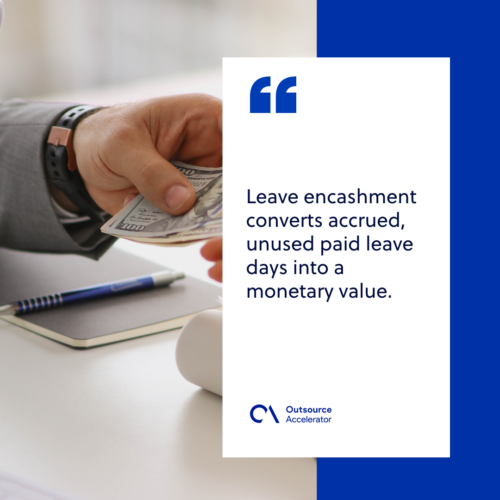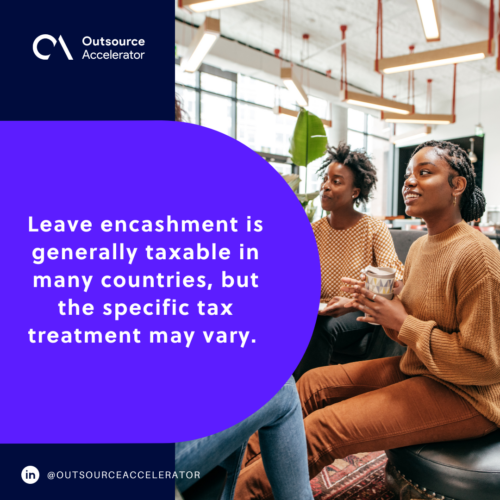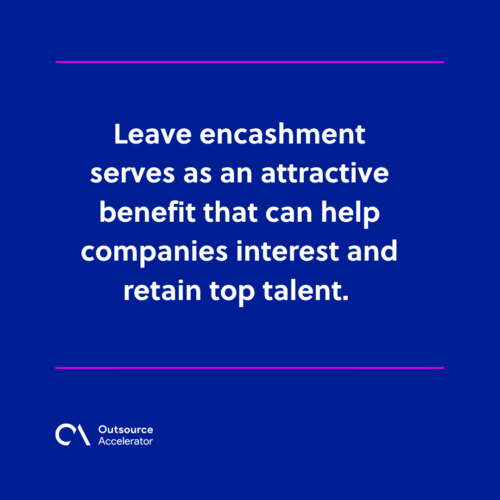Leave encashment: Your path to financial resilience

Leave encashment is a valuable benefit that many organizations give to their employees.
While that concept might seem straightforward, employers and employees must understand a few complexities and nuances.
This article delves into how leave encashment works, its benefits, and some considerations companies should keep in mind.
What is leave encashment?
Leave encashment converts accrued, unused paid leave days into a monetary value.
Leave encashment plays a significant role in the overall compensation package, allowing employees to receive financial benefits for their earned leaves. It also compensates for their unutilized leaves, which can be beneficial if they resign or retire.
The terms and conditions of leave encashment may vary based on company policies, employment contracts, and applicable labor laws.

Types of leaves
Employees may be entitled to various types of leaves, which serve different purposes and allow time off for various reasons.
Here are some common types of leaves:
Vacation leave
Employees are granted a certain number of paid days off each year for rest, relaxation, and personal activities. The purpose of annual vacation leaves is to provide employees with time to recharge and spend quality time away from work.
Sick leave
Sick leave allows for paid time off when employees are ill or need medical attention. It supports health and well-being while ensuring they don’t lose income.
Parental leave
This type of leave also covers maternity and paternity leaves. It provides time off for new parents to nurture their children, especially for mothers to recover from childbirth.
Parental leave aims to support parents during this important life event.
Family or dependent care leave
This type of leave is for employees to care of sick family members or dependents who need assistance. It acknowledges the need for employees to balance work and family responsibilities.
Bereavement leave
Bereavement leave allows employees to take time off to cope with losing a close relative. It offers them the space to grieve and make necessary arrangements.
Public holiday
These are designated days on which businesses and offices are typically closed to observe national or cultural holidays. Employees are generally entitled to a day off with pay on these holidays.
Compensatory leave
Compensatory leave is given to employees who have worked extra hours beyond their regular schedule. It allows them to take time off to balance the additional time worked.
Educational leave
Some companies offer study or educational leave to employees seeking to enhance their skills or pursue further education. This leave may be paid or unpaid and is typically granted for a certain period.
Unpaid leave
In certain situations, employees may request unpaid leave for personal reasons not covered by other types of leave. Unpaid leave allows employees to take time off while retaining their position, although without pay during the absence.
Sabbatical leave
Sabbatical leave is an extended time off. It’s usually granted to employees after a certain number of years of service.
Sabbatical leave allows employees to pursue personal projects, further education, or travel.
Is leave encashment taxable?
Leave encashment is generally taxable in many countries, but the specific tax treatment may vary.
Here are some points to remember regarding the tax implications of leave encashment:
- Income tax – The amount received through leave encashment is considered part of the overall income and thus subject to tax at the applicable rate.
- Taxation rate – The rate at which leave encashment is taxed can vary depending on factors like the total amount, the employee’s income tax slab, and any specific provisions in the tax code.
- Exemptions and deductions – Some countries may provide exemptions or deductions under specific conditions.
- Employer contributions – Sometimes, the employer’s contributions to employee benefits might be treated differently for taxation purposes.
- Timing of taxation – The timing of taxation can vary based on when the leave encashment is paid.
- Reporting and documentation – Employees and employers are generally required to accurately report leave encashment as part of the individual’s taxable income.
- Special circumstances – Different rules may apply in specific situations, such as retirement, resignation, or termination.
- International implications – If an employee works in one country but is a resident of another, there could be implications related to double taxation treaties.

Calculating leave encashment
The calculation method for leave encashment can vary based on company policies, local labor laws, and the terms of employment.
Depending on the company’s policy or local regulations, the formula for calculating leave encashment is:
Leave Encashment Amount = (Accrued Leave Days) x (Daily Basic Salary)
or
Leave Encashment Amount = (Accrued Leave Days) x (Basic Salary / Total Working Days in a Month)
Benefits of leave encashment
Leave encashment offers several benefits for both employees and employers:
Benefits for employees
Below are the benefits of leave encashment to employees:
Financial flexibility
Leave encashment can be utilized however the employees want, giving them greater financial flexibility.
This can be especially valuable during times of unexpected expenses, emergencies, or when facing financial challenges. It allows employees to access funds without resorting to borrowing or loans.
Supplemental income
Encashing unused leave days can supplement an employee’s regular income. This extra income can be used for various purposes, such as paying off debts, making investments, or saving for future goals.
Transition periods
When transitioning between jobs or career paths, leave encashment can provide a financial cushion during the transition period.
This can be particularly valuable if there is a gap between leaving one job and starting another.
Benefits for employers
On the hand, here are the advantages of leave encashment to employers:
Employee morale and loyalty
Offering leave encashment demonstrates that the company values its employees’ hard work and commitment. This can boost employee morale, job satisfaction, and overall motivation.
They’re also more likely to develop a sense of loyalty, which reduces turnover.
Positive image
Leave encashment serves as an attractive benefit that can help companies interest and retain top talent. It shows that the company values employee well-being and provides flexible benefits.
This helps build a positive public image and enhances reputation.

Flexibility in compensation
Leave encashment provides an alternative form of compensation beyond regular salary and benefits. This flexibility in compensation packages allows employers to tailor rewards to employees’ individual needs and preferences.
Employers can positively impact their workforce and the organization’s bottom line by including leave encashment in their employee benefits package.







 Independent
Independent




